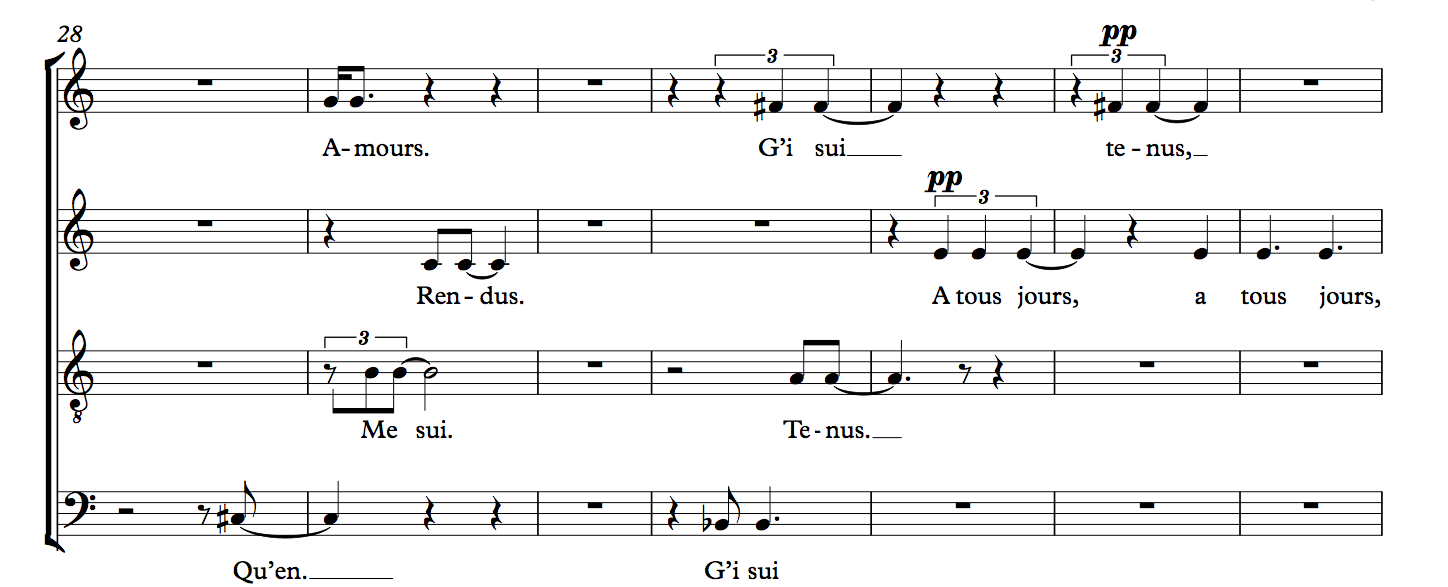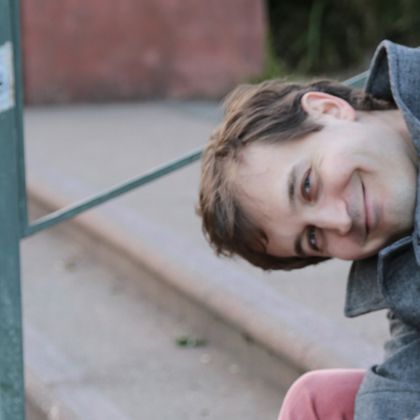Photo CC by Anthony Kelly, posted to Flickr
The well-prepared voice
I ended my last SoundMakers post by discussing how John Cage’s prepared piano studies influenced the approach I took to processing the voice in Longuement me sui tenus. Here, I want to go into a little more detail on how the electronics changed the type of vocal writing I used.
Writing for voice is not like writing for most other instruments, largely because each voice is unique. Singers take liberties with a score that other musicians wouldn’t in order to make the music work for their vocal chords. This isn’t a criticism—it’s one of the things I love the most about working with vocalists. However, it also means that I need to have that in mind when I “prepare” their voices digitally: even though I am changing the fundamental characteristics of the sound, I have to preserve the singers’ ability to adapt the piece to their individual voices.
Vibrato and tessitura
The first question to address was the role of vibrato, since the audio patch wraps every sound in a long, echo-y blanket of resonance, like a piano with the damper pedal down. This is the opposite of virtually every normal singing scenario, where the problem is usually a lack of resonance, not too much. I therefore had to decide how much, if any, vibrato would be appropriate for the piece.
A lot of composers have a general aversion to sung vibrato, but I’m not one of those. Over the years, I’ve realized that it’s more important to find the right singer for your piece. Once you’ve got him or her, you’re not going to improve anything by meddling with the way they sing. At most, I might ask the singer to lay it on thick or to go easy, but I leave those definitions open. After all, if the voice sounds good, your piece will sound good, and if the singer sounds uncomfortable or strained, your piece will sound one-dimensional and flat.
That said, given the nature of the electronics in Longuement, anything more than the most subtle touch of vibrato would destroy all sense of harmonic structure, making the piece nondescript and muddy. That’s not the kind of piece I wanted to write, so I limited myself to musical materials that can be sung comfortably in straight tone.
Essentially, what this means is that I had to write choral-style lines. I restricted each voice to its choral range, wrote primarily in the most comfortable octave for each type, and paid careful attention to what dynamics were used in which register. Each voice type produces each range differently—this is the essence of tessitura. For example, if you write low Cs and Ds for a soprano at fortissimo, the only way she’ll get there is by “belting” it, dropping into a huskier chest voice sound. You can’t expect the same bell-like clarity you’d get near the top of the treble staff.
Moreover, classically trained sopranos don’t prioritize the development of their belting technique, since it isn’t featured in much of their repertoire (the opposite is true for Broadway singers). That means you should only use loud chest voice with a classical soprano when you absolutely need it; it’s much safer to write quiet dynamics in that register.

An example of a quiet passage in the lower tessitura, near the start of the piece. Each voice is kept in a range where quiet singing with minimal vibrato is easy and idiomatic.
Dynamics and microphone bleed
The second question to address was how to prevent bleed between the vocal mics. The singers need to hear each other, which means standing close together, but their mics need to be kept isolated. To help with this, I specified highly directional microphones in the score—SM58s or shotgun mics—but even then, loud dynamics would inevitably result in some bleed between mics, blurring the effect of the different delay lengths on each voice. To make the piece effective, the only option was to rely primarily on quiet dynamics.
At first, I toyed with the idea of keeping the whole piece at piano or lower. However, I wasn’t getting the kind of expressive contrast I needed, so I eventually loosened up my requirements. Still, I stayed in the neighbourhood of piano whenever possible, stretching up into the mezzo-fortes and fortes only at strategic points, and writing those louder passages in a style where bleed between mics wouldn’t be as big of a deal.

One of the few forte passages in the piece, toward the end. The restricted, choralistic range allows the singers to minimize vibrato without straining the voice. In addition, the slow-moving, held tones sung in unison rhythm make bleed between microphones unimportant to the sonic effect.
As it turns out, this method of restricting your dynamics is also useful as a compositional muse: it forces you to be really meticulous about crafting lines and pacing phrases effectively. The end result was a very fluid and (to my ears) emotionally satisfying development that fits elegantly into each voice’s comfort zone.
Selecting musical materials
With those baseline concepts in place, I still needed to decide what types of musical materials would best suit the piece. Traditional vocal music prizes legato lines, and as such a lot of vocal writing is designed to help the singer achieve a smooth, flowing melody. Given the electronics, however, legato is automatic: there’s no way for me to avoid it. This pushed me towards types of musical phrasing more common in the piano repertoire, where composers have been exploring the similar acoustic possibilities of the damper pedal for nearly two centuries.
In the end, I settled on five major kinds of material—none of them traditionally vocalistic, but all of them idiomatic to the voice. It’s also worth noting that I didn’t catalogue all of these before writing; I only had the first two at the start. But as the piece evolved and I got a clearer sense of where it was heading, I found myself drawing on these additional techniques. I’ve described them below, along with an example for each, synthesized in SuperCollider:
1. Spaced harmonies – The opening of the piece relies on the long decay of each voice to build harmonic structures. One voice sings alone and then stops, but the sound continues digitally. Another voice, meanwhile, sings on top of the ongoing resonance. This allowed me to create cascades of vocal harmonies that bleed one into the other.
2. Heterophonic monody – A related concept involves layering one or two voices on top of themselves. Instead of leaving space for the harmonies to overlap, the singers repeat a single note, with short gaps in between. This creates an ebb and flow on a single pitch, or an alternation between two pitches.
3. Rhythmic homophony – When all the vocalists sing the same rhythm together, their collective presence is enough to override the delay effect—we still hear it, of course, but it becomes more of a background resonance instead of an extension of the voice. Therefore, whenever I needed rhythms to be clear and articulate, I relied on unison rhythms.
4. Staccato counterpoint – Borrowing a trick from the piano repertoire, I often made use of staccato singing to build up a counterpoint in a single voice. I have the singer sing a short, split-second passage, followed by silence. The delay line picks up the fragment and echos it, then the singer enters again with additional staccato material. All of these rhythmic fragments bounce around each other and build up a texture of vocal articulations.
5. Resonant runs – Once in awhile, I wanted to take advantage of the “muddy” side of the delay patch for effect. I don’t do this often in the piece, but it fits in strategically at points. I found that I could create a sort of cascading cluster effect by having the vocalists sing fast scales.
This article originally appeared on the SoundMakers composer-in-residence blog.


